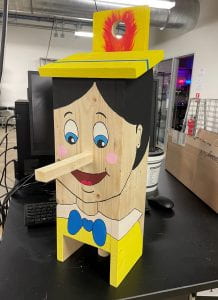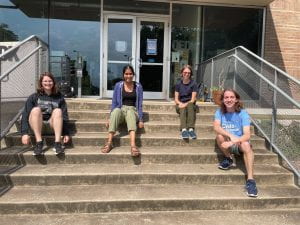Just over a week ago, I made the solo 9-hour drive from my home in Arkansas to Houston. It was fast-yet-slow in the way that car rides tend to be, especially when your eyes are on the road instead of the endless scenery around you. Listening to a variety of albums, I had plenty of time to consider the purpose of my return. In just a few hours I would be unpacking my things, and in a few days I would be sitting in a room with about two dozen other interns in the OEDK, ready for a summer experience like no other.
And, just as my imagination would have it, there we were. Dispersed in the OEDK classroom at 9:00 AM. As people engaged in scattered conversation, there was a latent energy in the space. Today was mostly introductions and formalities, but tomorrow, we would get our assigned projects, and our assigned team members. Today we could take our deep breaths, but tomorrow we would jump into the deep end of our engineering projects, with team members we haven’t even met yet.
The Project
When I heard the first project description, I was scribbling my notes in cursive, trying to get all the details. I thought, “Yep, that’s the one I want.” Then, the next project was described, and the next, and each one seemed to get even better than the one before. When I was picking my project preferences, it took me a great deal of time to order my top three, because they all seemed like amazing opportunities. I finished the first day of the SEED internship flush with excitement. Tomorrow was a day that, however ordinary, would determine my fate for the next six weeks.
I was ecstatic. Of course, I knew that I would like one of my top three projects, but now the project felt like mine. After meeting my teammates, I knew that this was going to be a fun time. We started by studying our challenge:
In many regions of the world, it can be difficult to acquire safe, clean drinking water. This can be a cause of waterborne illness, which affects large numbers of people worldwide. One way to help communities experiencing this is by testing water for E. coli, which is a bacterial indicator for fecal contamination. However, proper incubation of petri dishes or petri-films for E. coli requires a constant temperature of 35-37 degrees Celsius for up to 48 hours, and typical incubators are very large, cumbersome, and require AC power, which can be unreliable in certain areas of the world. Therefore, our client sought a portable, battery-powered field incubator for Petrifilm, which could hold the optimal temperature for growing E. coli over 48 hours. Our newly created squad, which we named Team Petri-FI, was tasked with improving the prototypes of previous student teams by making the device more portable and functional. We were off to the races.
Excitement Builds
To begin our project, we began the process of reading client documents and performing research to learn more about the incubation of E. coli. We compiled a document with as many sources as we could find about how water testing was performed, and how E. coli related to the problem of waterborne illnesses. On the more technical side, we also researched how incubators maintained their internal environment and looked into control units, such as Arduinos, for managing the temperature inside the device. By the end of Wednesday, we were bursting with hypothetical ideas, and we were itching to talk to our client so that we could gain a strong sense of direction for our project.
On Thursday afternoon, we met with our client over Zoom. In particular, we were able to hear about the motivation behind the project. Our client gave us extremely useful context for our design challenge, and it helped us to think more clearly about the goals of our design. When we zoomed back to the problem as a whole, it is quite amazing that we as students can contribute to solving problems like these in low-resource areas. Toward the end of the week, we had learned enough about our project to know that it would be a great challenge for this summer, but Team Petri-FI is more than prepared to roll up our sleeves and tackle it head-on.
On a more personal level, I saw great potential in this project to develop skills that I have wanted to improve for a while. Although I have focused much of my energy into studying mechanical engineering, I have long been interested in programming and computer science. I have written hundreds of lines of code, either in competitions or just for myself. However, this will be the first time that I have a chance to see my code manifested in the real world. I have not worked with an Arduino before, but I am excited to apply my knowledge of coding to the physical challenge of maintaining temperature inside an incubator and recording important information from the device. Furthermore, I will also get a chance to develop and build the circuits that will make our prototype function. Overall, this project is a large step out of my comfort zone, but I am excited for the opportunity to learn new skills over these six weeks.
The Bat House of Bonding
I experienced an unexpected highlight of the week during the hand tools workshop, which was designed to teach us about the hand tools in the OEDK. This workshop was made more interesting by the fact that we were split up into random teams to construct wooden bat houses with some drawings and our newly-acquired knowledge of hand tools. Although our team’s members did not yet know each other well, we embarked on our mission with unparalleled camaraderie.
As many things do, this task quickly became a competition with the other teams. Even though we took longer than other teams to cut our wood, our patience gave more time for creativity to blossom within us. We clamped wood, drilled holes, fastened pieces together with screws and nails. Finally, we had erected our structure, a modest bat house with more than a few mistakes. That was our only assigned task; however, we saw an opportunity to smooth out the edges and create a work of art. Unprompted, our team gathered sand paper and brought the coarse plywood to a smooth finish with our hands. Then, we wood-glued a piece of scrap wood onto the front as a nose, realizing that it would be a shame not to paint the bat house to commemorate our hard work.
The next day, we discussed our vision for the final paint design, inspired by the long wooden nose glued to the front of the bat house. Upon returning from Team Petri-FI’s client meeting, I was greeted with by work of art at the OEDK: Pinocchio himself!
 This exercise taught me some things that I’m glad I learned in the first week of the SEED Internship. First, never underestimate the artistic talent of your teammates, because they will often surprise you. Second, it is extremely rewarding to push beyond the expectations and boundaries of the tasks we are given. With just a little extra time and a brilliant vision, our team chose to go beyond the expectations, for only our own satisfaction. Experiences like this remind me to always be learning and pushing the boundaries of my own knowledge, because it just might lead me to create new and exciting solutions to the problems I face. I am extremely thankful to my teammates for choosing to put their best effort into this mini-project, and I’m glad that I was able to share this memory with them.
This exercise taught me some things that I’m glad I learned in the first week of the SEED Internship. First, never underestimate the artistic talent of your teammates, because they will often surprise you. Second, it is extremely rewarding to push beyond the expectations and boundaries of the tasks we are given. With just a little extra time and a brilliant vision, our team chose to go beyond the expectations, for only our own satisfaction. Experiences like this remind me to always be learning and pushing the boundaries of my own knowledge, because it just might lead me to create new and exciting solutions to the problems I face. I am extremely thankful to my teammates for choosing to put their best effort into this mini-project, and I’m glad that I was able to share this memory with them.
-Kenton Roberts
